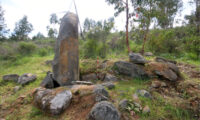 Archaeologists have discovered the largest megalithic complex in Spain near Heulva, on the southwestern border with Portugal. An extraordinary profusion of more than 500 menhirs, dolmens, stone cists, circular enclosures and standing stones have been documented at the site, plus associated finds like extraction areas, engravings, dry stone structures and quartzite hammers. Samples from the site are still in the process of being dated, but preliminary estimates are that the first vertical stones were erected between the Middle Neolithic to the Early Bronze Age, from the 5th millennium B.C. to the 2nd. The sacred spaces were then reused over the centuries.
Archaeologists have discovered the largest megalithic complex in Spain near Heulva, on the southwestern border with Portugal. An extraordinary profusion of more than 500 menhirs, dolmens, stone cists, circular enclosures and standing stones have been documented at the site, plus associated finds like extraction areas, engravings, dry stone structures and quartzite hammers. Samples from the site are still in the process of being dated, but preliminary estimates are that the first vertical stones were erected between the Middle Neolithic to the Early Bronze Age, from the 5th millennium B.C. to the 2nd. The sacred spaces were then reused over the centuries.
The megaliths were found in 2018 during a survey of a 600-hectare farm whose owner wanted to plant avocadoes. Andalusian authorities would only grant a permit for the avocado plan on condition that archaeologists get to explore the site first. Several megaliths have been found in the area before and previous farming of the land had significantly altered the landscape, so archaeologists were dispatched to perform an intensive surface survey before the estate was further transformed by agricultural use.
The team recorded all of the visible megaliths and documented four delimited groupings: a group of dolmens, a set of menhirs and two stone circles. They documented 526 megaliths in different shapes and sizes, most of them erected close to the outcroppings where the builders had sourced the stone.
One of the most striking things was finding such diverse megalithic elements grouped together in one location and discovering how well preserved they were, said Primitiva Bueno, co-director of the project and a prehistory professor at Alcalá University, near Madrid.
“Finding alignments and dolmens on one site is not very common. Here you find everything all together – alignments, cromlechs and dolmens – and that is very striking,” she said, hailing the site’s “excellent conservation”.
An alignment is a linear arrangement of upright standing stones along a common axis, while a cromlech is a stone circle, and a dolmen is a type of megalithic tomb usually made of two or more standing stones with a large flat capstone on top.
Most of the menhirs were grouped into 26 alignments and two cromlechs, both located on hilltops with a clear view to the east for viewing the sunrise during the summer and winter solstices and the spring and autumn equinoxes, the researchers said.
Located on a hill above the Guadiana River, La Torre-La Janera is the highest altitude site in the area, so these megalithic groupings would have been highly visible in the landscape as well as having a fine view for solar ceremonies.
The avocado plantation has been officially laid to rest. Instead, the site is undergoing a rigorous six-year project of excavation, study and conservation that is scheduled to run through 2026.